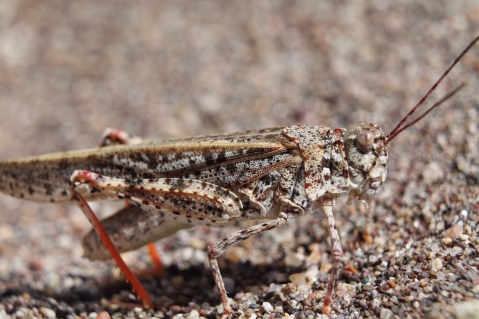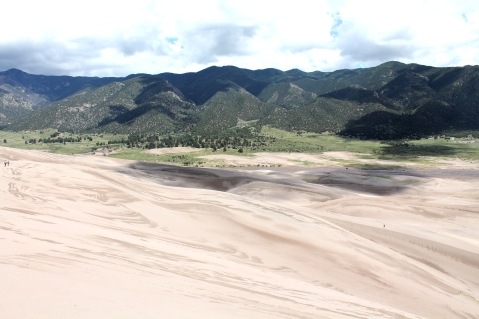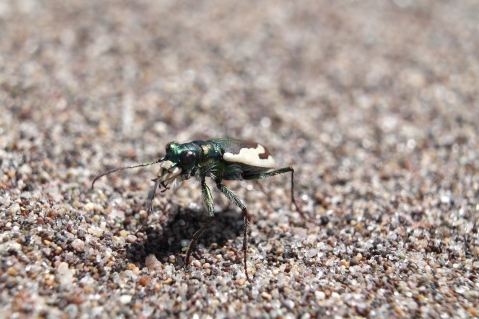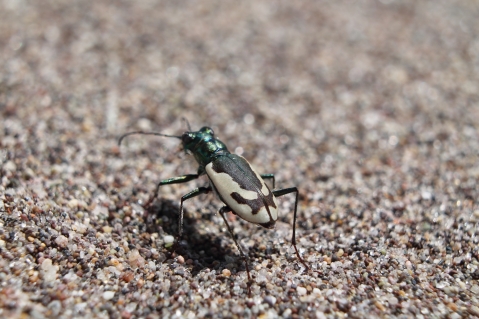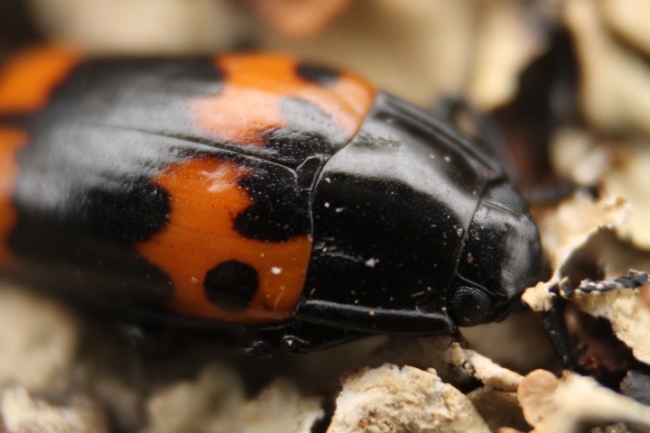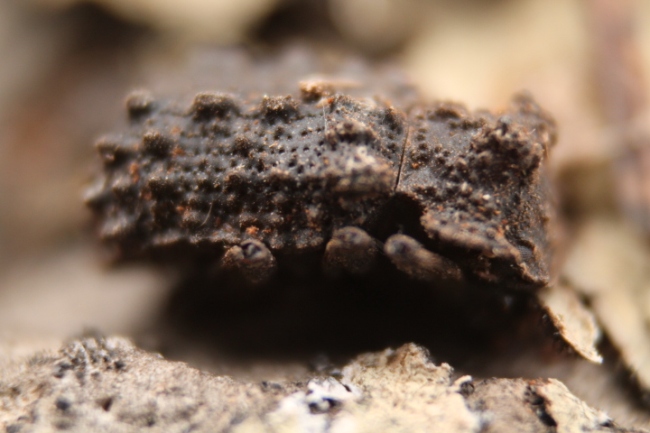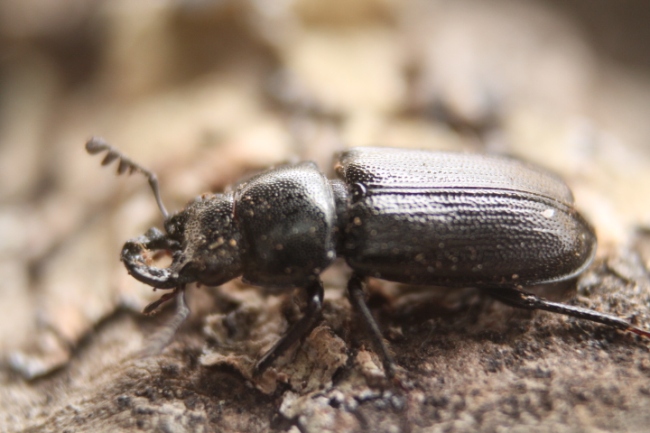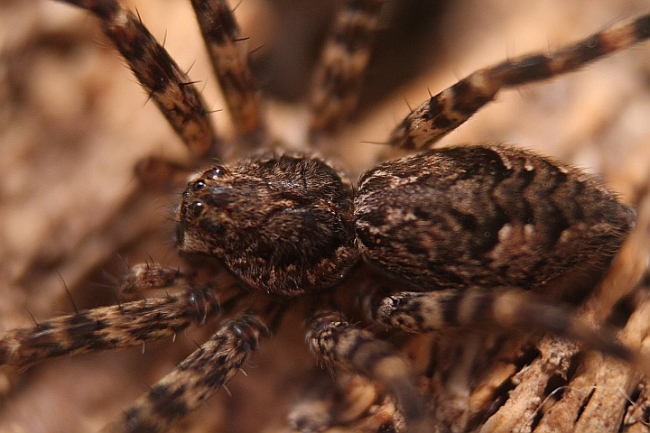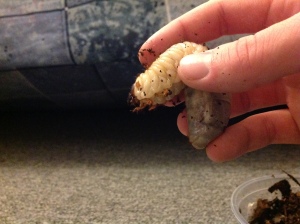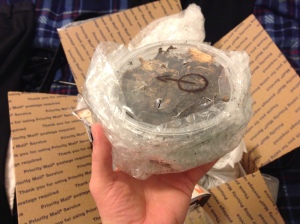Great Sand Dunes National Park
Recently I went on a family vacation out to Colorado. While of course we were there to see the scenery and do some hiking, but I just couldn’t pass up the chance to do some collecting in a whole new state. The highlight of the trip for me had to be Great Sand Dunes National Park. This was a beautiful oddity, large sand dunes on the edge of the Rocky Mountains. Even stranger was that people could rent sand boards or sleds to go down the dunes once they reached their desired height. Looked like fun though!
One of the things that really struck me about this place was that in the visitor center there were pictures of a tiger beetle everywhere! This was something I hadn’t seen before. The staff at the park were actually trying to educate people on an insect. There were postcards, pennies, a painting, a whole display dedicated to the beetle’s ecology…it was an amazing thing to come across. Needless to say, I got very excited and wanted to try to find one of these beetles.
The Great Sand Dunes tiger beetle (Cicindela theatina) is a species endemic only to these dunes. This gives it a very small habitat and people are allowed to partake in recreational activities throughout the dunes. While this sounds like bad news for C. theatina, people aren’t as active in the places where the beetles are. Instead, they prefer to climb the dunes or play in Medano Creek. That and ATVs aren’t allowed in the park, dramatically cutting down on habitat damage (unlike what is seen at Utah’s Coral Pink Sand Dunes State Park).
After crossing the creek, I casually wandered about the vegetation before making my way up the dunes. There were plenty of small bees flying about, always catching my eye, but never being C. theatina. There were a large number of grasshoppers as well, perfectly camouflaged and springing up at the last moment.
The sparse vegetation still offered a refuge to invertebrates, especially those fleeing the hungry robber flies.
Finally I saw one! A beautiful C. theatina zipped in front of me. I got down to try to get a picture and off it went. I saw where it landed though and tried again. Same result. Third time’s the charm right? Wrong. After a couple more attempts, the beetle decided it had had enough of my nonsense and flew off where I couldn’t see it. It was a disappointing, but exhilarating moment (or should I say 15 minutes) because it meant that the beetles were here and I just had to keep trying. But first, I had to walk up the dunes with my family. The view from where we stopped was breathtaking, even if we didn’t climb the highest dune (699 feet is definitely up there, but we still managed to break 500 feet).
As they say, going up is the hard part, and how right they were. It took the better part of an hour to reach our highest point, but only about 10 minutes to get back down. Descent would have been faster with a sand board, but it was more entertaining to watch other people try that approach (spoiler: there were several people that went face-first into a dune). Once at the bottom, I beelined for a patch of vegetation to continue my search. Apparently I had chosen well, for there were at least 10 C. theatina that fled my approach. Moving much more cautiously, I managed to sneak up on a nice specimen. And then he was gone. Not to be stopped, I followed another who was running across the sands. I got close, it ran. I got close again, it ran. Repeat this several times (and include the girls that were just watching me and laughing as I army-crawled after this beetle) and finally I got my shots!
This is a gorgeous beetle, with lovely coloring and a great pattern. It cooperated with me for about a minute and then flew off to do tiger beetle things. I’m sure I could have given chase for more images, but I was just happy that I got the ones I did. This ended up being my highlight of the entire vacation, even though I did collect several very nice beetles. It’s just hard to beat a unique and rare species such as this. These beetles need to be protected so that future generations can enjoy them, from an entomological perspective and from the perspective of someone who takes joy in seeing something so small and beautiful.
For some more fun reading on C. theatina, check out this Beetles in the Bush post here.
First Collecting Trip (12 April 2014)!
The weather has finally gotten nice (except for the snow today…) and I was able to go collecting! Though early in the season, there were some insects and spiders out. I went to a local forest (a rare island in the sea of corn that is central Illinois), packed and ready for a variety of things. While there wasn’t any vegetation I could use my beating sheet on, there were still plenty of logs that could be flipped or broken and lots of peelable bark.
The morning started off slow, but things picked up as the day went on and we figured out what logs and bark could yield the insects we were after. And what could a better find than a bunch of beetles???
This beautiful erotylid (pleasing fungus beetle) was under a piece of loose bark at the base of a dead tree. The same tree had a large number of dead curculionids (weevils) and coccinellids (lady beetles) under the bark. They all seemed to be infected with fungus, but that could have occurred after they died. Perhaps the frigid temps from this past winter killed them off and the fungus began breaking them down?
After waiting over a year, I was finally able to capture the amazing forked fungus beetle (Family Tenebrionidae)! She was well camouflaged in a rotting log, likely looking for fungus to eat. This is one of the few non-lucanids that show sexual dimorphism, with males having large “fork-like” horns rising over their heads. Females (like the one seen above) have small bumps. While small, they are occasionally kept in the US beetle hobby. Hopefully I’ll find a male this year so I have a pair!
The log with the B. cornutus also contained several oak stag beetles (Family Lucanidae)! This small stag beetle (maxing out at 12 mm) was a very cool find. I didn’t know this beetle existed until I found it and it was a pleasant surprise to find a lucanid so early in the season.
And on an 8-legged note, a couple flipped logs also yielded young fishing spiders (Dolomedes tenebrosus) and a jumping spider (not yet identified).
Couldn’t have asked for a better way to start the season! Here’s looking forward to collecting even more this year!
The Arrival
I’m a bit behind on this post, but I couldn’t resist. While my posts have been pretty focused on tarantulas right now, I can mix it up with a cool post about beetles.
Breaking open rotting logs in forested areas is a favorite past-time of mine. You never really know what you will find. Something that is in almost every log is beetle larvae. A variety of larvae can be found, from click beetle to stag beetle. I’ve tried casually keeping larvae I’ve found before, but my success rate has been pretty low (with flat bark beetles being my only real success). But then I came across a forum for beetles, where people keep native and exotic beetles and beetle larvae. The clincher was when I got my beetle breeding and rearing book (seen in “In Pursuit For Knowledge“). The book proved to be an extremely good read and I learned an unbelievable amount about keeping beetles and beetle larvae.
But after reading and reading and reading, I was finally ready to take the plunge into serious beetle keeping (cue dramatic music). Now a very glaring question arises. Where the heck do I get adult beetles or larvae? Certain families can be readily found around here, but after several previous attempts with smaller species, I wanted to start off with a bang. I scoured beetleforum.net until I came across an interesting species that was considered to be a good beginning species. Sounds good right? I figured I would get a couple larvae, rear them out, and get some decent sized beetles that I would breed and sell the larvae off. But after I bought the larvae and they arrived, I was in for quite the surprise.
These larvae were massive. To be honest, I really didn’t know what to expect, but it wasn’t something this large! I was extremely excited and quickly placed the sexed larvae (that’s right, you can sex them before adulthood as long as they are final instar) into a large enclosure with more than enough rotting wood for them to feast on after their long(ish) journey.
Shipping larvae is pretty sweet. You just place them in a cup of some sort with substrate/food, put some padding in the box and around the cups and send them off. And let me tell you, the guy who sent them to me did a heck of a job with the packing. It’s cold here, but priority shipping is always and option with beetle larvae. They don’t have to be shipped express, so that saves you some money right off the bat, and you get to recycle those pesky old deli cups!
Oh, I forgot to mention what species I’m keeping? Silly me. They may not look particularly exciting now (besides the whole massive part), but in a few months they will. My first beetle species to keep is…Allomyrina dichotoma, aka, the Samurai helmet beetle!
For more information on A. dichotoma, check out these links:
http://carnivoraforum.com/topic/9680884/1/
https://www.facebook.com/media/set/?set=a.435138719898779.102520.430512957028022&type=3
I’m really hoping to get lucky with theses guys and get some breeding adults. I would only have one male and one female, but you gotta start somewhere, right?


